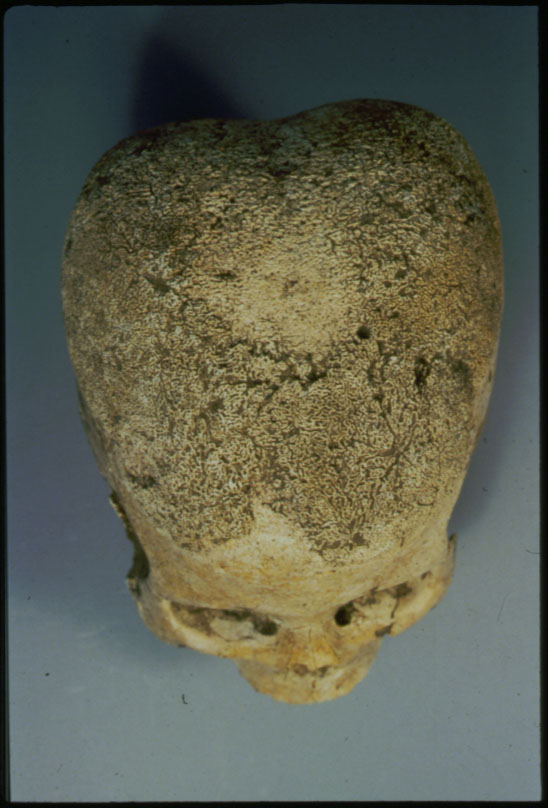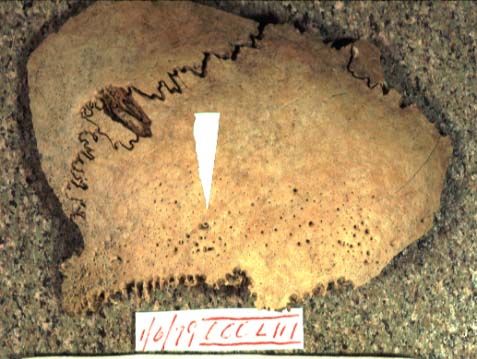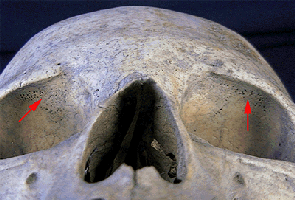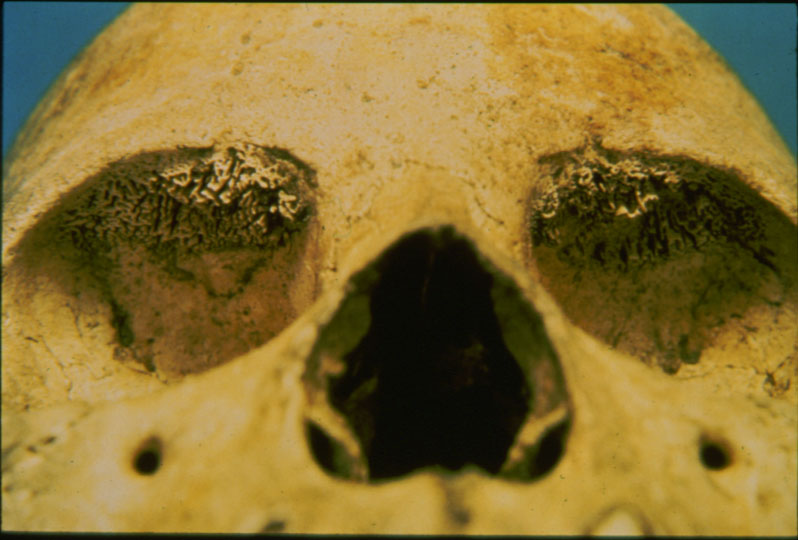Paleopathology 
A great deal of interest has come from studying the remains of early agricultural populations in order to see the effects that converting from a hunting and gathering way of life to a settled, agricultural life had on these populations. It is now known that iron from plants was harder to absorb, and compounds called phytates present in staple crops such as maize, and rice inhibit iron absorption in the body. This is the reason why as populations relied more and more on these types of foods, the incidence of iron-deficiency anemia began to spread. Today, much of the world's population is estimated to be iron deficient (Robers, 1997).
The two main types of lesions observed in every type of anemia involve the skull. Porotic hyperostosis and cribra orbitalia (which some paleopathologists group into the same category with PH) are caused by the body's attempt to produce more red blood cells in the marrow to compensate for lack of iron. The longer this iron deficiency continues, the more apparent these lesions become (Roberts, 1997)
Although many skeletons have other "general stress" lesions such as lines of arrested growth present in long bones known as Harris lines and stress-derived lines present on the tooth enamel known as enamel hypoplasia, only porotic hyperostosis and cribra orbitalia can be considered as being direct signs of some type of anemia, while the other lesions have more to do with episodes of great stress, or severe malnutrition not related to a lack of supplemental iron in the diet.
Porotic Hyperostosis
Porotic hyperostosis, or PH is commonly characterized by cranial vault
lesions symmetrically distributed over the parietals, and frontal bones,
and the occipital in rare cases (Ortner,2003). Several cases studied
around the world by paleopathologists such as Patricia Stuart-Macadam,
B. Rothchild, P. L. Waker, A. M. Palkovich, and Jane Buikstra, among
others have found a similarity between PH and a lack of iron in paleodiets.
Stuart-Macadam & Kent (1992) emphasize that iron-deficiency anemia is probably the most common cause of porotic hyperostosis worldwide, and that it may be beneficial in infancy since iron is essential for many bacteria to grow (Ortner, 2003).


"Porotic hyperostosis" http://www.usd.edu/~archlab/paleopics/metabol.html
"cccliii" http://www.usd.edu/~archlab/paleopics/metabol.html
Cribra Orbitalia
The other definite indicator for the presence of anemia in human remains
are the pores present in the bone surface of the orbital roofs, otherwise
known as cribra orbitalia. Active lesions of anemia were only observed
in the young,(up tp 12 years) after which the frequency of lesions decreased
with time (Roberts, 1997). Since most anemia in past populations developed
during infancy, and faded when the individual reached adolescence, some
cases are found with an inactive form of cribra orbitalia, where the
orbital roof has begun remodeling itself, and pores are barely visible:


"Cribra" http://www.ucm.es/info/antropo/trancho/publicar.htm
While it is clearly visible in other cases how the rough shape, typical of constantly-adapting trabecullar bone is retained signifying an active case of anemia.
Some cases of anemia are so severe, that both types of lesions are observable in the same cranium. Researchers performed studies trying to figure out if the presence of an infection in these cases is perhaps inducing the body to develop iron-deficiency anemia. At times the body can, in fact, hide iron reserves from bacteria that attack the body which need the iron to proliferate. These causes could also be interpreted as a function of many other factors such as climate, geography, hygiene, diet, time period, and economy (Stuart-Macadam, 1992).

"both" http://www.usd.edu/~archlab/paleopics/metabol.html